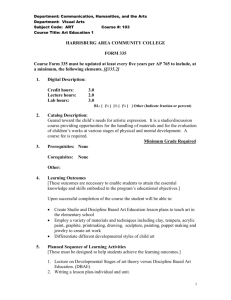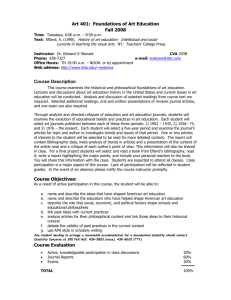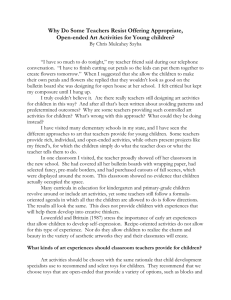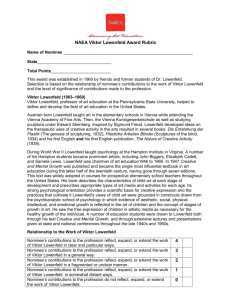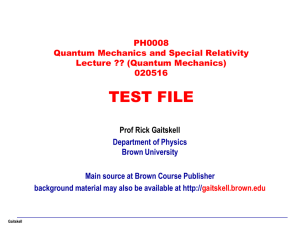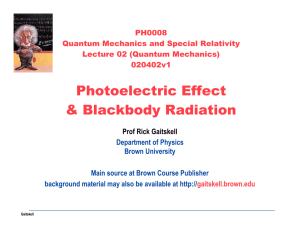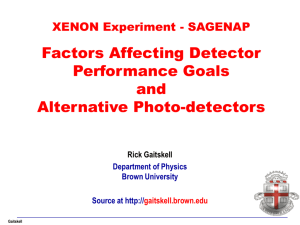Historically, the field of art education has not emphasized assessment
advertisement
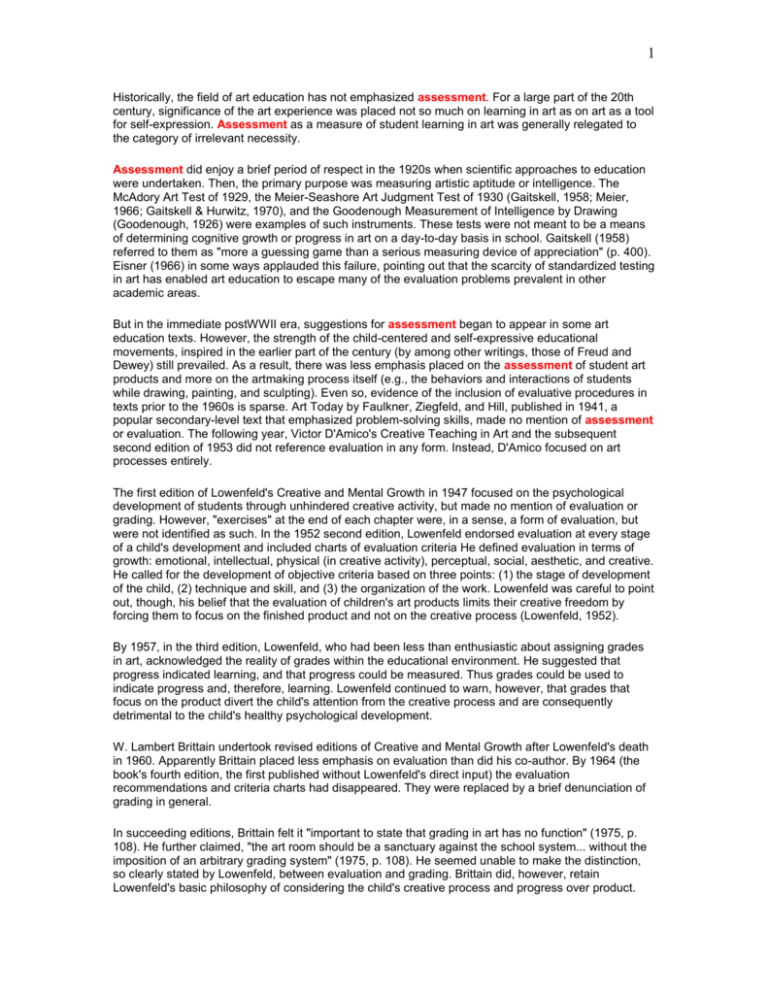
1 Historically, the field of art education has not emphasized assessment. For a large part of the 20th century, significance of the art experience was placed not so much on learning in art as on art as a tool for self-expression. Assessment as a measure of student learning in art was generally relegated to the category of irrelevant necessity. Assessment did enjoy a brief period of respect in the 1920s when scientific approaches to education were undertaken. Then, the primary purpose was measuring artistic aptitude or intelligence. The McAdory Art Test of 1929, the Meier-Seashore Art Judgment Test of 1930 (Gaitskell, 1958; Meier, 1966; Gaitskell & Hurwitz, 1970), and the Goodenough Measurement of Intelligence by Drawing (Goodenough, 1926) were examples of such instruments. These tests were not meant to be a means of determining cognitive growth or progress in art on a day-to-day basis in school. Gaitskell (1958) referred to them as "more a guessing game than a serious measuring device of appreciation" (p. 400). Eisner (1966) in some ways applauded this failure, pointing out that the scarcity of standardized testing in art has enabled art education to escape many of the evaluation problems prevalent in other academic areas. But in the immediate postWWII era, suggestions for assessment began to appear in some art education texts. However, the strength of the child-centered and self-expressive educational movements, inspired in the earlier part of the century (by among other writings, those of Freud and Dewey) still prevailed. As a result, there was less emphasis placed on the assessment of student art products and more on the artmaking process itself (e.g., the behaviors and interactions of students while drawing, painting, and sculpting). Even so, evidence of the inclusion of evaluative procedures in texts prior to the 1960s is sparse. Art Today by Faulkner, Ziegfeld, and Hill, published in 1941, a popular secondary-level text that emphasized problem-solving skills, made no mention of assessment or evaluation. The following year, Victor D'Amico's Creative Teaching in Art and the subsequent second edition of 1953 did not reference evaluation in any form. Instead, D'Amico focused on art processes entirely. The first edition of Lowenfeld's Creative and Mental Growth in 1947 focused on the psychological development of students through unhindered creative activity, but made no mention of evaluation or grading. However, "exercises" at the end of each chapter were, in a sense, a form of evaluation, but were not identified as such. In the 1952 second edition, Lowenfeld endorsed evaluation at every stage of a child's development and included charts of evaluation criteria He defined evaluation in terms of growth: emotional, intellectual, physical (in creative activity), perceptual, social, aesthetic, and creative. He called for the development of objective criteria based on three points: (1) the stage of development of the child, (2) technique and skill, and (3) the organization of the work. Lowenfeld was careful to point out, though, his belief that the evaluation of children's art products limits their creative freedom by forcing them to focus on the finished product and not on the creative process (Lowenfeld, 1952). By 1957, in the third edition, Lowenfeld, who had been less than enthusiastic about assigning grades in art, acknowledged the reality of grades within the educational environment. He suggested that progress indicated learning, and that progress could be measured. Thus grades could be used to indicate progress and, therefore, learning. Lowenfeld continued to warn, however, that grades that focus on the product divert the child's attention from the creative process and are consequently detrimental to the child's healthy psychological development. W. Lambert Brittain undertook revised editions of Creative and Mental Growth after Lowenfeld's death in 1960. Apparently Brittain placed less emphasis on evaluation than did his co-author. By 1964 (the book's fourth edition, the first published without Lowenfeld's direct input) the evaluation recommendations and criteria charts had disappeared. They were replaced by a brief denunciation of grading in general. In succeeding editions, Brittain felt it "important to state that grading in art has no function" (1975, p. 108). He further claimed, "the art room should be a sanctuary against the school system... without the imposition of an arbitrary grading system" (1975, p. 108). He seemed unable to make the distinction, so clearly stated by Lowenfeld, between evaluation and grading. Brittain did, however, retain Lowenfeld's basic philosophy of considering the child's creative process and progress over product. 2 In 1955, Frederick Logan wrote one of the few creditable histories of art education in the United States, Growth ofArt in American Schools. It covered in great detail interactions between social changes, the practice of the arts, and the growth of art education. Despite its detail, including predictions for the future of art education in the schools, only a terse mention was made of tests and measurements in art. In 1958, Charles Gaitskell wrote what may be the most consistent and comprehensive source of assessment information. In Children and Their Art, Gaitskell discussed the "appraisal" of student progress in art. Like other writers, Gaitskell advocated attention to process and progress over product. He proposed three areas of consideration for the appraisal process: expression, appreciation, and behavior. Gaitskell, moreover, suggested a list of appraisal techniques for use by art teachers: objective and essay-type tests, anecdotal records, observations, checklists, interviews, and cumulative records. He continued to refine his ideas and by 1970, in the second edition, had modified the categories to expression, reaction, and behavior. In both editions, he advocated objective-based appraisal. Also, in the second edition, he introduced the idea of using Bloom's taxonomy (1954) in the appraisal process, a concept that continued to reappear in subsequent editions including the sixth edition of 1995. June McFee's 1961 first edition of Preparation for Art advocated the then popular, but shortlived, trend away from letter grades for children. Furthermore, she flatly stated a belief that would soon be echoed by Brittain "letter grades have little value in art" (p. 209). McFee, who placed little emphasis on the evaluation of learning or the assignment of grades in the first edition of Preparation for Art, altered her position in the second edition published in 1970. In it, she included an entire chapter on evaluation. This chapter listed several techniques that teachers could use to obtain information about student learning in art. She recommended observational strategies and provided examples of observational criteria and corresponding forms for recording data. Manuel Barkan was well known for being perhaps the most influential figure during the 1960s in leading the field toward greater structure and discipline. Indeed, we will have more to say about Barkan later. Surprisingly, however, in his 1960 book, Through Art to Creativity, Barkan made little reference to evaluation and no recommendations regarding assessment or the assigning of grades. In 1965, Frank Wachowiak and Theodore Ramsey co-authored Emphasis: Art. The book was well received, and a second edition was published in 1971. Emphasis: Art was aimed at the elementary art teacher and provided comprehensive guidance and instruction in art processes appropriate for elementary age students, but did not address evaluation. Thus far, we have reviewed the checkered history of assessment theories and practices in art education up to about 1970. From this point, we will briefly review a transition in the field that began to ferment in the 1960s and eventually became a major development. This has to do with the growing interest in structure, as well as teachers' reactions to that development. An important catalyst for this change of view were the writings of Jerome Bruner, particularly his 1963 The Process of Education. Although Bruner's work was limited to the teaching of language arts, art education writers applied his ideas to their field. One of Bruner's basic arguments was that learning is more effective if it takes place within the framework of a discipline. Building on Bruner's ideas, Manuel Barkan (1962, 1963) proposed the concept of structure and discipline in art education. This theme was the focus of the Penn State Seminar in Art Education for Research and Curriculum Development held at the Pennsylvania State University in 1965. The ideas generated at this conference resulted in an influential publication popularly known as the Penn State Papers (Mattil, 1966), published the following year. Two anthologies appearing in 1966, Ralph Smith's Aesthetics and Criticism in Art Education and Readings in Art Education by Elliot Eisner and David Ecker further promoted the idea of art as a distinct academic discipline. Smith brought together several essays on art history, art and film criticism, and educational theory. Eisner and Ecker assembled a number of writings by curriculum theorists, psychologists, educational philosophers, and aestheticians, as well as art educators, past and present. 3 One chapter contained five, mostly theoretical, articles on evaluation. Eisner's "Evaluating Children's Art" (pp 384-388) was the most valuable in this regard. In it, the author addressed a number of issuesphilosophical, theoretical, and practical-but in the end, Eisner, like others, advocated evaluating progress rather than product. The transition from an emphasis on self-expression to a focus on structure and content was occurring primarily in the academic literature, namely, Art Education Journal and Studies in Art Education and in some art education graduate programs, but not in the schools-in many instances, not even in teachertraining programs. Indeed, this disconnect existed not only in the 1960s but continued right on through the 1970s and into the 1980s. It is not surprising then that, given this fact along with the lingering effects of the child-centered and self-- expressive movements in the postwar period, teachers of art largely ignored the exhortations of structure advocates. In the elementary grades, especially, art teachers continued to emphasize creative art production and self-expression at the expense of structured lessons and measuring the progress of students. Prior to the 1980s, their mission continued to be that of fostering healthy child development. The role of the art teacher was primarily that of media facilitator. But all of this began to change in the 1980s. The movement of Discipline-Based Art Education, or "DBAE," materialized, along with the influence of a significant outside source, The Getty Center for Education in the Arts. Without chronicling these developments or ignoring the fact that they are not without controversy, there is no doubt that DBAE and Getty have dramatically changed the mood and outlook in art education, right down to the classroom. While the principles of DBAE may have been borrowed from the literature of the 1960s, specifically the writings of Barkan, the Penn State Papers, Eisner, Ecker, Smith, et. al., DBAE nevertheless was successful in proffering an understandable synthesis and a catchy label that caught on with classroom art teachers. W. Dwaine Greer, a leader in the DBAE movement, in an article published in Studies posits art in the schools not as primarily a developmental activity but as a serious subject of study (Green 1984). During this art education epiphany, however, the issue of evaluation was dealt with mostly on a theoretical level, if at all. Treating art as a serious subject of study suggests a need for developing serious procedures of assessment, including ways of evaluating art products as well as progress. But while art education writers have said much about rigor and structure and, perhaps, the need for assessment, little has been done to promote practical and reliable assessment methods. Scholarly articles often present rationales for assessment, but seldom offer technical procedures for implementation. For example, one recent survey of 89 articles on portfolio assessment over 10 years found only 7 articles that reported any technical data or methods (Herman & Winters, 1994). Doug Boughton (1997) reported that in a survey of Studies in Art Education written between 1959 and 1974 he found, "that the smallest category, only 5% (14 articles), dealt in any way with evaluation, and these were concerned mainly with program evaluation, rather than student assessment" (p. 199). Things haven't changed much since then. In an informal survey of Studies in Art Education covering the years 1988 through 2001, the writers of this article found that of a total of 376 articles, 18 dealt with assessment or evaluation. Of that number, only 9 described any form of methodology or application. (Boughton's article in the fall 1997 issue did indeed address application, but it focused on a model called "Community as Arbiter" model, rather than a practical assessment model for an art teacher working alone.) Conclusion Over the years, there has existed a sort of love-hate relationship between art education and assessment-with most of it being on the hate side. Some art education writers openly denounced evaluation. Others, as if in a state of denial, ignored the issue all together. Still others reluctantly accepted a limited amount of evaluation, while warning against its harmful effects on creativity or free expression. Finally, many felt comfortable by controlling the issue under the aegis of measuring progress rather than product. But even these advocates rarely explained how to establish a defensible baseline for doing so. 4 Even the advocates of structure in the 1960s and 1970s ignored the issue, and continued to do so even when their agendas evolved into DBAE in the 1980s and 1990s. Now, with the call for accountability in all of education, including art education, assessment has come to the forefront with a vengeance. And art education has not adequately done its homework. The authors of this article acknowledge that no single kind of assessment can provide a representative and accurate measure of student learning in art. What is probably needed is a variety of strategies that include testing, observation, products, and portfolios. But in any case, the field of art education needs to give much more attention to the issue in terms of not only scholarly analysis, but especially in terms of developing understandable guidelines for classroom art teachers. [Sidebar] In the elementary grades, espically, art teachers continued to emphasize creative art production and selfexpression at the expense of structured lessons and measuring the progress of students. Prior to the 1980s, their mission continued to be that of fostering healthy child development. The role of the art teacher was primarily that of media facilitator. [Sidebar] Without chronicling these developments or ignoring the fact that they are not without controversy, there is no doubt that DBAE and Getty have dramatically changed the mood and outlook in art education, right down to the classroom. [Sidebar] Now, with the call for accountability in all of education, including art education, assessment has come to the forefront with a vengeance. And art education has not adequately done its homework. [Reference] REFERENCES [Reference] Barkan, M. (1960). Through art to creativity. Boston: Allyn and Bacon, Inc. Barkan, M. (1962). Transition in art education: changing conceptions of curriculum content and teaching. Art Education, 15 (7), 12-18. Barkan, M. (1963). Is there a discipline of art education? Studies in Art Education, 4 (2), 4-14. Barrett, T. (1995). Lessons on art criticism. ERIC: Art (Indiana University) and Santa Monica, CA: The Getty Center for Education in the Arts. Bloom, B. S. (1954). Taxonomy of educational objectives. Handbook 1. Cognitive domain. New York: Longmans, Green. Boughton, D. (1997). Reconsidering issues of assessment and achievement standards in art education. Studies in Art Education, 38 (4), 199-213. Bruner, J. (1963). The process of education. Cambridge, MA: Harvard University Press. [Reference] D'Amico, V. (1953). Creative teaching in art (2nd ed.). Scranton, PA: International Textbook Co. Eisner, E. W., (1966). Evaluating children's art, in E. W. Eisner & D.W. Ecker (Eds.), Readings in Art Education (pp 384-388). Waltham, MA: Blaisdell Publishing Co. Faulkner, R., Ziegfeld, E., & Hill, G. (1941). Art today. New York: Holt, Reinhart, & Winston. Gaitskell, C.D. (1958). Children and their art: Methods for the elementary school. New York: Harcourt, Brace and Co. Gaitskell, C.D., & Hurwitz, A. (1970). Children and their art: Methods for the elementary school, (2nd ed.). New York: Harcourt, Brace & World, Inc. Gaitskell, C. D., & Hurwitz, A. (1975). Children and their art: Methods for the elementary school, (3rd ed.). New York: Harcourt Brace Jovanovich, Inc. 5 Gaitskell, C. D., & Hurwitz, A. (1982). Children and their art: Methods for the elementary school, (4th ed.). New York: Harcourt Brace Jovanovich, Inc. Gaitskell, C. D., & Hurwitz, A. (1995). Children and their art: Methods for the elementary school, (6th ed.). New York: Harcourt Brace Jovanovich, Inc. Goodenough, F. L. (1926). Measurement of intelligence by drawing. Yonkers, NY: World Book Co. [Reference] Greer, W. D., (1984). A discipline based art education: Approaching art as a subject of study. Studies in Art Education, 25 (4), 212-218. Herman, J. L., & Winters, L. (1994). Portfolio research: A slim collection. Educational Leadership, 52 (2), 4855. Logan, F. M. (1955). Growth of art in American schools. New York: Harper & Brothers. Lowenfeld, V. (1947). Creative and mental growth: A textbook on art education. New York: MacMillan. Lowenfeld, V. (1952). Creative and mental growth: A textbook on art education, (2nd ed.). New York: MacMillan. Lowenfeld, V. (1957). Creative and mental growth: A textbook on art education, (3rd ed.). New York: MacMillan Lowenfeld, V. & Brittain, W. L. (1964). Creative and mental growth: A textbook on art education, (4th ed.). New York: MacMillan. Lowenfeld, V. & Brittain, W. L. (1975). Creative and mental growth: A textbook on art education, (6th ed.). New York: MacMillan. [Reference] Mattil, E. (1966). A seminar in art education for research and curriculum development (Cooperative Research Project V002). University Park, PA: The Pennsylvania State Papers. McFee, J. K. (1961). Preparation for art. Belmont, CA: Wadsworth Publishing Co., Inc. McFee, J. K. (1970). Preparation for art, (2nd ed.). Belmont, CA: Wadsworth Publishing Co., Inc. Meier, N. C. (1966). Factors in artistic aptitude: Final summary of a ten-year study of a special ability in E. W. Eisner & D. W. Ecker (Eds.), Readings in art education (pp. 105-116). Waltham, MA: Blaisdell Publishing Co. Smith, R. A. (1966). Aesthetics and criticism in an education. Chicago: Rand McNally. Wachowiak, F., & Ramsey, T. (1965). Emphasis: Art. A qualitative program jbr the elementary school. Scranton, PA: International Textbook Co. Wachowiak, F., & Ramsey, T. (1971). Emphasis: Art. A qualitative program for the elementary school, (2nd ed.). Scranton, PA: Intext Educational Publishers. [Author Affiliation] Donald D. Gruber recently received a Doctorate in Art Education from Illinois State University. He is a visual art instructor in Clinton Community Schools, Clinton, IL. Jack A. Hobbs is Emeritus Professor ofArt at Illinois State University, Normal. E-mail: teacher1@wsys. net or jhobbs@ilstu. edu

